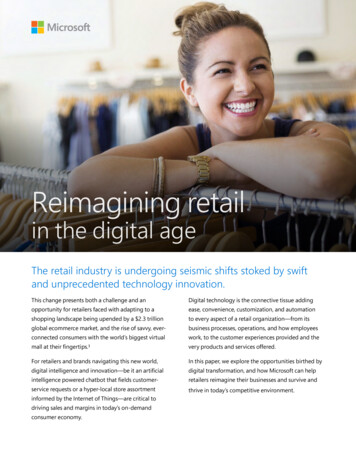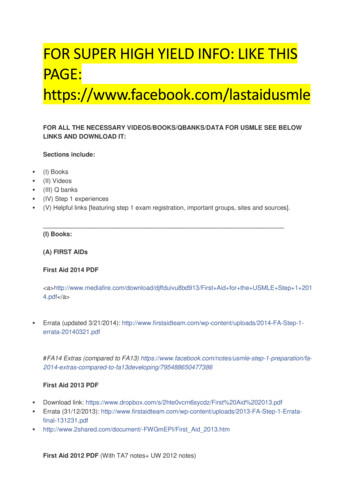
Transcription
Reimagining retailin the digital ageThe retail industry is undergoing seismic shifts stoked by swiftand unprecedented technology innovation.This change presents both a challenge and anDigital technology is the connective tissue addingopportunity for retailers faced with adapting to aease, convenience, customization, and automationshopping landscape being upended by a 2.3 trillionto every aspect of a retail organization—from itsglobal ecommerce market, and the rise of savvy, ever-business processes, operations, and how employeesconnected consumers with the world’s biggest virtualwork, to the customer experiences provided and themall at their fingertips.¹very products and services offered.For retailers and brands navigating this new world,In this paper, we explore the opportunities birthed bydigital intelligence and innovation—be it an artificialdigital transformation, and how Microsoft can helpintelligence powered chatbot that fields customer-retailers reimagine their businesses and survive andservice requests or a hyper-local store assortmentthrive in today’s competitive environment.informed by the Internet of Things—are critical todriving sales and margins in today’s on-demandconsumer economy.
The forces changing retailRetailers are facing challenges coming from a myriadof directions. Disruptive shifts like the explosion ofonline and mobile shopping have thrust retailers, nowcompeting in a global omnichannel marketplace, into afierce battle for the ever-fragmenting wallet share—andmindshare—of consumers.Meanwhile, an overstored U.S. retail sector built for a preAmazon era is in resizing mode, and the store’s role in theshopping experience is changing, further driving the needfor new business models that generate growth.Evolving customer behavior and preferences are primarycatalysts for change. For the new instant-gratificationconsumer, smartphones increasingly serve as theindispensable portal to their personal, social, workplace,and shopping lives, used to pay bills, book a hotel, sharevacation photos on social networks, or buy a coffeemaker.Further challenging retailers, shoppers are spending moreon experiences like restaurants and spa visits, thantangible things.Meanwhile, they are channel agnostic, and expect aseamless, curated shopping journey that reflects theirpurchasing behavior and preferences, whether they’rebuying online, from a mobile device, in-store, or somecombination of the three. As a result, “Consumers expecttheir experience to ‘automagically’ adapt whenever theyengage physically, digitally and emotionally,” according toan Accenture report.²The new retail reality is that whatever the best experiencethe shopper has, regardless of where and how it wasdelivered, now sets the expectation for the industry—whether retailers are equipped to deliver it or not.Consequently shopper-buying triggers have changed.Spoonfed marketing and advertising messages holdinfinitely less sway, as consumers turn to online customerreviews, the opinions of their peers on social networks, andinfluencers that include self-made YouTube stars forproduct recommendations.Reimagining retail in the digital age//2
Transforming your retail business: four key pillars ofdigital-transformation successAs retailers stare down these new expectations, they’refinding that longtime business practices designed to boostmargins and foster customer loyalty won’t guaranteeongoing success. To stay relevant and compete in a rapidlyevolving industry, retailers must reimagine their customerexperiences and business processes from the ground up byimplementing technology in new ways.Microsoft is working with retailers to take advantage oftoday’s innovations to unlock new opportunities to changeand grow, built on four key pillars.Engage your customers to create personalizedand seamless shopping experiences thatinfluence buying behaviorRedefining customer engagement calls for predicting thewants and needs of shoppers, whether they’re in store, athome, or on the go, and delivering convenient, personalized,contextually relevant messaging, merchandise, and shoppingexperiences, fueled by data-driven technology solutions, frombeacons and sensors to cross-channel analytics. Deliveringmeaningful shopper engagement also calls for recognizingthe multichannel shoppers across their “phygital” (digitaland physical) touchpoints, and speaking consistently to anaudience of one.Empower your employees to delight consumerswith outstanding service at every point along theshopping journeyEmpowering your employees with state-of-the-arttechnology that weaves inventory visibility and advanceddata analytics throughout the retail supply chain iscritical today, so that retailers can nimbly adjust theirmerchandising strategies to reflect customer preferences inreal time, for example.Reimagining retail in the digital ageEmpowering employees also means equipping in-store salesstaff with customer-service enhancing mobile workforcetools that can locate an item for a shopper, for example, aswell as automate, bring greater speed and precision to keyretail tasks, from stocking shelves to setting up displays.Optimize your operations to build an agileretail organizationRetailers can now optimize their operations with technologyplatforms that transform reams of complex data signals—from shoppers’ digital and physical footprints to externalfactors such as the weather, season, and time of day—intoactionable insights that take product demand forecastingand customer targeting to new heights.Optimizing business processes in a now-digital retailmarketplace also means using a unified commerce platformthat delivers friction-free, seamless customer experiencesacross buying channels, which is key to serving today’smultichannel shoppers.Transform your productsRetailers must transform their products to meet shoppers’craving for personalized, timesaving services andexperiences on demand: from offering one-of-a-kind,3D-printed products to customizing a kitchen via mixedreality technology. The idea is to excite, delight, and solveunmet needs via tech-enabled retail servicesand experiences.For merchants, the potential return on investment froma digital makeover is significant. Retail companies thatembrace digital transformation and mine their dataintelligence can potentially realize an additional 94 billionin revenue over companies that do not. Key opportunityareas include employee productivity ( 41 billion),operational improvement ( 29 billion), product innovation( 15 billion), and customer-facing experiences ( 9 billion).//3
In the next section, we’ll outline how these four Microsoft pillars arehelping reimagine retail and accelerate transformation, and showcaseindustry leaders that are seeing meaningful results.Digital transformationEngage yourcustomersTransformyour productsCustomeroutcomesEmpower youremployees@Optimize youroperationsHelping society move forward is deeplygrounded in Microsoft’s mission of empoweringevery person and every organization on theplanet to achieve more. For business that meansa digital transformation.”SATYA NADELLACEO, MicrosoftReimagining retail in the digital age//4
Engage your customersThe digital shopping landscape has trained consumersto expect customized interactions, merchandiserecommendations, and product offers based on theirbuying habits and purchasing patterns.But legacy retailers have struggled to deliver these bornin the web, technology driven personalized customerexperiences and information in physical environments.Targeted advertisements and product offers have provensuccessful for retailers online and via mobile devices, butextending that success to brick-and-mortar stores hasbeen elusive.That’s now changing. Digital tools such as beacons, thecloud, the Internet of Things, machine learning, mixedreality, and artificial intelligence technology are catalyzingpersonalized and seamless experiences for shoppers inphysical stores, too.It’s what shoppers want, which is reflected in retailinvestments. Today, 40 percent of retailers say apersonalized customer experience is their top priority,and 61 percent expect personalization technologies togenerate a meaningful return on investment.3Anticipate shopper needs in the micro-momentWith Microsoft predictive analytics solutions, retailerscan track product demand and manage inventory levelsand store locations, including from mobile devices, whileoffering consumers a measure of curation and conveniencethat brings new value to the shopping journey.A shopping scenario informed by Microsoft digitalintelligence solutions might play out something like this:a consumer planning a vacation to Rome asks a retailer via achatbot messaging app on her smartphone to recommenda few key fashion items for her trip.The retailer would then harness the power of predictiveanalytics, using real-time data streams as well as socialmedia platforms, such as the shopper’s Pinterest board,to recommend styles she might like. Culling from this richmix of data intelligence, the retailer would recommendpersonalized items, and then offer to reserve them for theshopper to try on at its nearest store.Reimagining retail in the digital ageThe shopper then goes to the store, where a beacon sensorrecognizes her presence, as the store has already prepareda fitting room where her reserved items await. The “smart”fitting room features a touch screen whereby the shoppercan punch in requests for different sizes, colors, or othercomplementary items from the comfort of the dressing room,where store associates bring items to try on. The shopperthen purchases the items directly from her smartphone.A store associate receives a real-time notice of thepurchase, as well as a message such as, “This item has ahigher than expected demand. There are two left in stock.Order more now?”Technology solutions and services like Microsoft AzureMachine Learning, Microsoft Dynamics 365, Office 365,Power BI, SQL Server, and Microsoft Social Engagementmake this scenario possible today.While bringing new value to the consumer’s shopping trip,the journey is simultaneously tracked, which generates agoldmine of insights—like how many products make it fromthe fitting room to the checkout aisle—ones that retailerscan draw on to enhance and customize further shoppingexperiences.Maximize personalized, relevant shopperinteractions across retail touch pointsThe scenario illustrates how Microsoft digital solutions—such as the analytics that anticipated what items theconsumer might like for her trip before she did and thebeacons that directed her to an available fitting roomonce she was in the store—can deliver personalized andcontextually relevant engagement across all touchpointsin the shopper journey.The data-driven journey points to deepened customerengagement that fosters loyalty and shopper retention bycapitalizing on mobility, immersive experiences, and unifiedcommerce capabilities, as the consumer is recognized andserved throughout her multichannel shopping trip.//5
Engage your customersThat shopping journey is further personalized with relevantoffers based on interests and location in the store, all thewhile the retailer gathers valuable information about theconsumer’s cross-channel shopping behavior.Optimize shopper interactions via social anddigital channelsThe scenario also reflects how savvy retailers arecapitalizing on the growing influence of social and digitalchannels, from Pinterest scrapbooks to Amazon. Shoppers aretapping these platforms to research products and services,express their opinions, and search for deals. That presentsbig opportunities for retailers using technologies such asMicrosoft Dynamics 365 to monitor customer sentiment,and the ongoing conversations bubbling on social networksand customer review sites, in turn allowing them to quicklyrespond to product and marketing trends.Reimagining retail in the digital ageTap AI to enhance, quicken customer serviceConversational commerce enabled by artificial intelligence,like chatbots, is redefining how consumers identify productsand services that meet their needs pre-purchase, like findingthose targeted items for Italy, and how they replenishgoods, such as instructing their voice-assistant device toreorder laundry detergent.It’s also transforming how retailers serve shoppers. Byconnecting customers with chatbot technology, AI inthe form of mobile or online virtual agents can improvecustomer service and support interactions, like handlinga return and dealing with a shopper complaint.Consumer culture is ripe for conversational commerce, asshoppers have an increasingly lower threshold for longtimeretail pain points, such as waiting on hold to resolve acustomer service issue. In turn, as 60 percent of all shopperpurchases are first influenced by visits to a digital channel,retailers are investing in it.4//6
Engage your customersCASE STUDYMacy’sWith annual sales of nearly 26 billion, Macy’s delivers fashion and affordableluxury to millions of customers shopping at its approximately 670 locations andonline store. Recognizing that shoppers are increasingly turning to online andmobile channels to browse and purchase merchandise, Macy’s is embracing digitaltransformation to provide personalized and optimized experiences that cater to allthe ways their customers want to shop.The retailer enhanced its website with a virtual agent based on the MicrosoftDynamics 365 AI solution for customer service. By connecting to Macy’s internalsystem APIs to access information about merchandise and orders, the virtualagent provides customers with real-time responses to common inquiries andproactively solves customer issues or transfers them to a live agent to continue theconversation.“We can see, in real time,what our customers areWith the virtual agent already answering more than one quarter of customerqueries, Macy’s plans to expand it to additional shopping channels.asking and how our answersLearn moreare performing, and we canmake adjustments on thefly to give our customers abetter experience.”“Becoming more engaged with customers includespredicting what customers want before they know theyROBERT MICHAELSDirector of Information Technology,Macy’swant it, based on data intelligence, and offering it tocustomers in a way that’s natural.”Satya NadellaCEO, MicrosoftReimagining retail in the digital age//7
Empower your employeesCustomer experience drives shopper loyalty—or doesn’tTraditional customer-service models that served retailers inthe analog-only era of bricks no longer cut it in a “phygital”shopping universe that straddles both bricks and clicks.Retailers are paying a higher price for missteps servingconsumers less tolerant of in-store hassles, like a storeassociate unable to locate an item that’s supposed to be instock. This pain point alone costs merchants 68.1 billionevery year, tarnishes customer service and good will, whilehurting worker productivity.5To defend market share and customer loyalty, retailers arescrambling to shift from functioning merely as transactionalsellers of goods, to service providers that ease and enrichthe path to purchase and complement digital channels.To that end, retailers are investing in transforming salesassociates into brand ambassadors and product experts withmore sophisticated training programs, and empoweringtheir front-line workers with assisted-selling technologiesthat redefine convenience and customization.Forward-thinking retailers are tapping Microsoft to helptheir employees elevate customer service with the latesttechnology tools, such as mobile workforce devices thatgrant access to real-time product, customer, inventory,and order details, so that workers are at least as informedas the customers they serve. These assisted-sellingsolutions empower sales associates to identify inventoryoptions from any location across an enterprise to meetcustomer demand.They also enable employees to share information fromany device, unifying digital, in-store, and back officeoperations. In-store sales associates with a direct line to thecustomer can now interact with headquarters workers likebuyer, marketing, and design teams, gaining newfoundvisibility into how customers respond to products, howmerchandising is working, and the effectiveness of in-storepromotions. The result is more nimble collaboration thatultimately benefits the shopper.Digital collaboration tools also replace manual paper andemail processes to increase worker productivity, automatingcommon tasks such as stocking shelves, prepping displays,and locating products.Today’s shoppers who research products online are morepurposeful spenders once they get to the store. They knowwhat they want, and they want it fast and painlessly, and ifthey need help, they want informed, tech-equipped staffto offer on the spot solutions. Indeed, 68 percent of globalshoppers cite the ability to check another store or onlinestock quickly for merchandise as key to a satisfyingin-store experience.6Reimagining retail in the digital age//8
Empower your employeesCASE STUDYLowe’sWith a purpose of “helping people love where they live,” Lowe’s is the secondlargest home improvement company in the world, with 2,200 stores locatedthroughout the United States, Mexico, and Canada. To help realize its purpose, theretailer wanted to empower its 260,000 employees with cloud-based productivitytools to more effectively tackle their jobs, collaborate between the corporate officeand stores, and ensure personalized customer connections.By deploying Microsoft Office 365 services company-wide, the retailer gaveits employees anytime access to productivity and collaboration tools, such asfile sharing and instant messaging, from any device. Lowe’s also expanded itsemployees’ email inboxes so they can receive photos from customers asking forhome project guidance.Now with everyone accessing a unified platform and the online version of Officeapps, employees can find information faster, work together more easily, anddevelop more attentive customer relationships to help bring their home projectvision to life.Learn more“We’ve empowered employeesto find and share theinformation that they need,which has definitely increasedteamwork and productivity. With all of our tools in thecloud, we can shift some ofour resources elsewhere to“It’s serendipity at work when you discover someonedeliver even better customerwho has the solution to a problem that stumps you.experiences.”You don’t need to rely on serendipity to get that result.All that knowledge and insight exists inside yourJUSTIN LITHERLANDinfrastructure—in your email, your documents, yourVice President of IT Stores,line of business applications—it’s just waiting to beLowe’sfound using organizational analytics, and provideinsight to what is going on.”Satya NadellaCEO, MicrosoftReimagining retail in the digital age//9
Optimize operationsFrom a tech-transformation standpoint, computing poweris digitizing nearly all retail functions from the warehouseto the store floor, providing merchants with ten times theinsights on its customers and business processes in onetenth the time.Optimizing operations is about enabling retailers to shiftfrom merely reacting to events to responding in real timeor even preemptively.Microsoft is working with retailers to optimize theiroperations to channel the power of data-driven insights tomake smarter, more agile decisions, from merchandisingto inventory management, and create hyper-local, relevantproduct assortments in stores.That ability is critical today, as the shopping landscapecalls for retailers to step up their speed to market to keeppace with an accelerated product trend cycle fueled bythe “democratization of information.” Indeed, in a world of“information abundance, customers can [turn to] a widevariety of influences when making buying decisions.”⁸At the same time, retailers must be equipped to conductomnichannel fulfillment, amid the growing popularity ofbuy online, pick up in
analytics, using real-time data streams as well as social media platforms, such as the shopper’s Pinterest board, to recommend styles she might like. Culling from this rich mix of data intelligence, the retailer would recommend personalized items, and then offer to res











